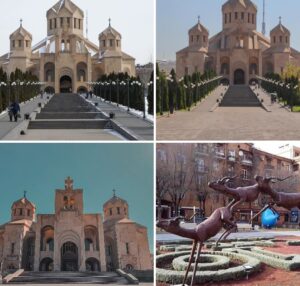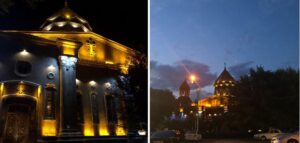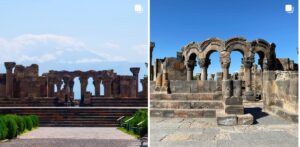10 Famous Cathedrals & Churches In Armenia | Historical Churches In Armenia

- By
- Aparna Patel
- |
- 19 May, 2023
- |
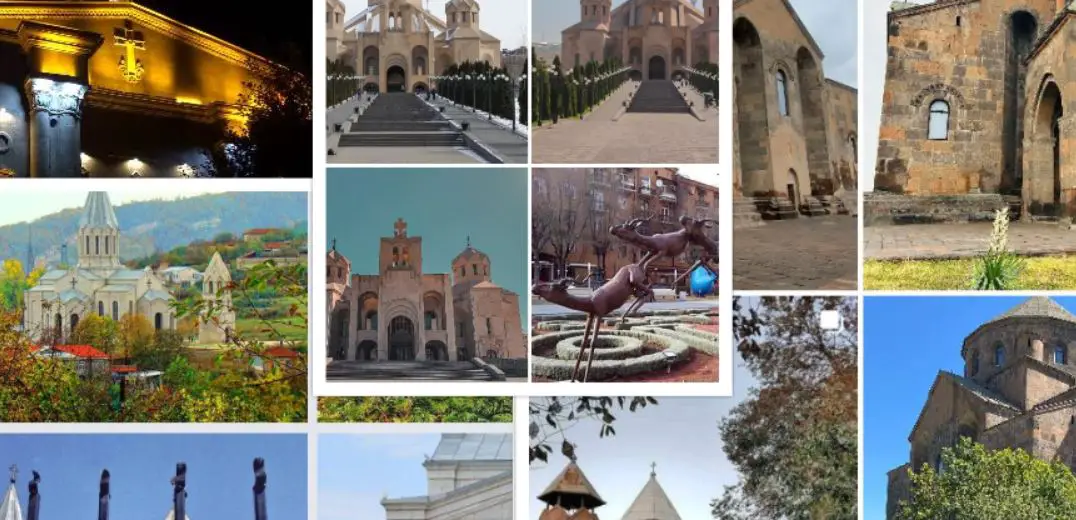
Armenia has a rich and fascinating history. There are many incredible churches and cathedrals scattered all over the country that have stood for centuries, many that have been a part of Armenia’s history since it was established.
In this post, we will explore some of the most famous historical cathedrals and churches in Armenia, highlighting their historical importance and the beautiful architecture that has been enjoyed by millions of visitors throughout the years.
Famous Historical Cathedrals & Churches In Armenia
1. Saint Gregory the Illuminator Cathedral, Yerevan
Saint Gregory the Illuminator Cathedral is an Armenian Apostolic church located in Yerevan, Armenia. It was opened in 2001 to celebrate the 1700th anniversary of the adoption of Christianity by the Armenian nation.
The cathedral is located in the center of Yerevan and serves as both a prestige monument to Armenian Christianity, as well as a pilgrimage site for Orthodox Christians. It is the largest cathedral in the Caucasus and the largest church in Armenia. It stands at a height of 90 meters, with a dome that is 53 meters in diameter.
The interior of the cathedral contains many works of art and religious artifacts, including a hand-carved khorovadz (altar table). The building is recognized as a symbol of Christianity in Armenia, and along with being a national religious site, the Armenian Catholicos Garegin II visits the cathedral occasionally.
2. Saint Hripsime Church, Echmiadzin
The Saint Hripsime Church in Echmiadzin, Armenia is a 7th-century Armenian Apostolic church. Its architecture is characterized by a central dome supported by two facades and four inner pillars. It is considered one of the oldest surviving churches in Armenia. It is located within the ancient city of Vagharshapat (present-day Echmiadzin), which is also home to the Mother See of the Armenian Apostolic Church.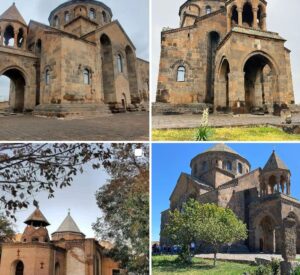
The church was built over the tomb of the 4th-century martyr Saint Hripsime, who was killed for refusing to marry the Emperor Diocletian. The interior of the church features a single main hall and several smaller chambers. Inside the main hall, one can find a mosaic depicting the Dormition of the Theotokos.
On the walls, there are several intricate frescoes depicting the life of Saint Hripsime. Outside the church are two bell towers as well as sculpted figures of saints. The church remains popular for its architectural beauty and religious significance, and is one of the most visited sites in Armenia.
3. Surp Amenaprkich Ghazanchetsots Cathedral, Shushi
The Surp Amenaprkich Ghazanchetsots Cathedral, also known as Shushi Cathedral, is located in Shushi, a city in the de facto Republic of Nagorno-Karabakh, and is one of the oldest churches in the region.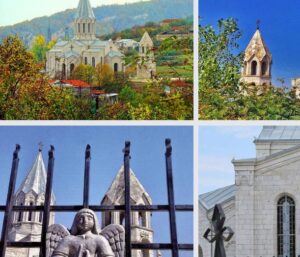
Built in the early eighteenth century, it is a classic example of Armenian ecclesiastical architecture and has been restored several times throughout its history, most notably in the early twentieth century. It was damaged during the Nagorno-Karabakh War as it was used as a military base by the Azerbaijani forces. The church was reopened for services in 2001 after extensive renovation works were undertaken.
The main building of the church is constructed of two-storied cuboid with two rows of four corner towers each. The façade is adorned with fire-stone masonry, decorative friezes, and some other decorations. Inside the church, there are two shrines of Saint John the Baptist and Saint Gregory the Illuminator. There is a chapel in the south-east corner of the Cathedral, which is dedicated to Saint Mark and his martyred companions.
The Surp Amenaprkich Ghazanchetsots Cathedral is a testament to the importance that Armenians have traditionally placed on their regions and their religious heritage. It is a symbol of the resilient spirit of the Armenian people and a source of great pride in the Shushi region of Nagorno-Karabakh.
4. Mother See of Holy Etchmiadzin, Vagharshapat
The Mother See of Holy Etchmiadzin, is the foremost spiritual and administrative headquarters of the Armenian Apostolic Church. Located in Vagharshapat, Armenia, it is recognized by the Mufti of the Republic of Armenia as the highest authority of the Armenian Church, and has a status of holy of holies, where members are not allowed except for the Supreme Patriarch and Catholicos of All Armenians and a few of his assistants.
The center of the Armenian Church, Etchmiadzin is believed to be the resting place of Jesus Christ’s Great Commission to the Apostles to preach the Gospel to all nations: “Go into all the world and preach the good news to all creation.
The original Cathedral of St. Etchmiadzin was completed in 303 AD and stands as the oldest officially recognized Christian cathedral in the world. The Cathedral is located in the heart of Etchmiadzin, and houses the Holy Altar of St. Gregory Illuminator, as well as many priceless artifacts and relics that date to the 4th century CE.
Etchmiadzin also houses a theological seminary and the famous Gevorkian Theological Seminary, which is one of the oldest seminaries in the world. Its library contains some of the oldest written records of Armenian church history and doctrine. The Monastery of Hripsime, located nearby, contains the remains of one of the oldest churches in the world.
The Etchmiadzin complex is a major pilgrimage site in Armenia and has become a symbol of Armenian national identity and pride. Every year, thousands of Armenian pilgrims come to Etchmiadzin to pay homage to the spiritual and cultural trappings of their people.
5. Cathedral of the Holy Mother of God, Gyumri
The Cathedral of the Holy Mother of God is a large Armenian Apostolic church located in the city of Gyumri, Armenia. It is the largest church in the city and stands as an important symbol of the history and culture of the Armenian people. Built in 1867, the cathedral was heavily damaged in the 1988 earthquake that shook the entire region.
It has since been restored and is now a functioning place of worship for the Armenian Apostolic Church. The cathedral is located in the center of Gyumri and is surrounded by a large park and gardens. It is open to the public and visitors to the area are welcome to explore the grounds and visit the interior of the cathedral.
6. Church of the Holy Cross, Lake Sevan
The Church of the Holy Cross at Lake Sevan in Armenia is one of the oldest and most important pilgrimage sites in Armenia. It is located at the top of a hill overlooking the lake, and its origins date back to the 7th century. The church is dedicated to the Holy Cross, which is the symbol of the Armenian nation and a representation of the country’s deep faith in Christianity.
The site is visited by both locals and visitors from around the world, with its popularity increasing every year. The church was constructed using local stones, and its architecture is a combination of both traditional Armenian and Byzantine styles.
It includes a large dome that is beautifully decorated and encircled by four pillars. Inside, there is a large wooden crucifix, and a series of small chapels, which are adorned with wood carvings. Visitors are able to climb to the top of the church to enjoy views of the lake, as well as the surrounding landscape.
The area around the church is home to several historical and cultural monuments, making the location a must-see for any traveler visiting Armenia.
7. Sourb Nshan Church, Oshakan
Sourb Nshan Church (also known as Holy Sign Church) is an ancient Armenian church in Oshakan, Armenia, built in 1873. It is a single-nave basilica with an apse, first built of cut stones. The façade has two doorways, both framed by two pilasters. The interior is covered with frescoes.
The inner walls are decorated with biblical scenes from the New Testament, carved from alabaster and marble. The church has an ornate chandelier, as well as a number of icons and religious artifacts. It is one of the most important religious sites in Armenia. The Sourb Nshan Church is a national monument of Armenia and is a popular tourist destination.
8. Zvartnots Cathedral, Vagharshapat
Zvartnots Cathedral is a 7th-century Armenian cathedral located in Vagharshapat, Armenia. One of the most important churches in Armenia, it is an architectural marvel and was built by Catholicos Nerses the Builder between 641 and 661. The cathedral was badly damaged in an earthquake in the 9th century, but parts of its walls are still standing alongside its reconstruction that was completed in 2001.
The cathedral has elements of Armenian architecture, Byzantine architecture, and elements from the Ancient Greek temple of Erechtheion. It is the only remaining archaeological site in Vagharshapat and has been officially listed as a UNESCO World Heritage Site since 2000.
9. Cathedral of Akhtala, Akhtala
The Cathedral of Akhtala is a 10th-century Georgian Orthodox church located in the town of Akhtala, in Armenia. The church is noted for its artistic and well-preserved murals, which cover the entire interior of the church including the vaulted ceiling. It is the only remaining part of a larger complex that also included a monastery. The church was built in 989 under the patronage of the prince of Tashir-Dzoraget, Grigor-Sumbat.
The church is constructed of white limestone and is in the tetraconch form which preceded the cross-domed style of Armenian churches. The entrance is framed by a two-tiered portal with a triangular gable above it. The dome rests on the four corners of the structure and has a conical covering.
The interior is covered with murals, of which the largest are three scenes from the life of Christ which occupy the drum and the four side walls. Other murals depict various biblical themes as well as numerous Georgian and Armenian saints. The 12th-century frescoes are considered masterpieces of Armenian art, and the Akhtala Gospel, which dates to the 14th century, is kept in the church. The cathedral was renovated in the 1990s.
10. Saint John Church, Qareh Qaq Castle
Saint John Church, also known as Qareh Qaq Castle, is a medieval Armenian monastery located in the southwestern province of Vayots Dzor in Armenia. It was constructed in the 10th century and is widely considered to one of the most important Armenian surviving ruins from this era.
This site is composed of a large church, three chapels, and a bell tower, and is notable for its unique blend of Armenian and Byzantine architecture. In 2004, the ruins were partially restored by the Institute of Archaeology and Ethnography of the National Academy of Sciences of Armenia.
The site is believed to have been the summer residence of the Kamsarakan families who were prominent Armenian princes from the 10th and 11th centuries.
Search Posts
Latest posts
-
4 Mar, 2024
How can I do a "broad" search for flights?
-
5 Mar, 2024
How to avoid drinking vodka?
Popular posts
-
5 Mar, 2024
Why prohibit engine braking?
-
5 Mar, 2024
How to avoid drinking vodka?
